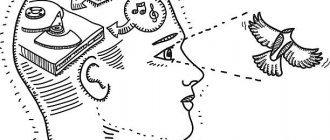Adherents of the concept of the activity approach have argued for a long time about the psychological structure of the individual in it.
By including a large number of different elements into the personality structure, such as characteristics of temperament, character, and mental processes, psychologists received an overly complex, large-dimensional model. For this reason, it was necessary to find a structure that would both receive theoretical justification and be practical.
In short, Leontiev’s theory was that the structure of a person’s personality does not come from his genes, inclinations, knowledge, or skills. Its basis is objective activity, namely the mechanism of relationships with the environment, which are realized through a hierarchy of various activities.
A person is in certain social relations. Some of them are leaders, and some are subordinates. The core of personality, thus, includes a hierarchical representation of these activities, which, in turn, does not depend on the state of the human body.
The main parameters of the personality structure are:
- the diversity of an individual’s relationships with the world through the prism of various activities;
- the degree of hierarchy of connections with the world and activities;
- a generalized structure of the subject’s connections with the surrounding world, formed by the internal relationships of the main motives in the totality of activities.
Objective circumstances form a personality through a set of activities. The individual develops only through creation, not consumption.
Brief biography of A. N. Leontyev
Leontyev Alexey Nikolaevich is a famous representative of psychology of the period 1940–70s in the USSR. He made a huge contribution to the development of Russian psychological science: the creation of a department of psychology at the Faculty of Philosophy, and then the Faculty of Psychology itself at Moscow University. Leontyev wrote a large number of scientific papers and books.
Alexey Nikolaevich Leontyev was born in 1903 in Moscow. Studied at Moscow University. Initially, he was interested in philosophy, as he had a desire to comprehensively evaluate the events that were taking place in the country at that time. However, then, on the initiative of G.I. Chelpanov, Leontyev wrote his first scientific works on psychology: a work on Spencer and an abstract on the topic “James’s Doctrine of Ideomotor Acts.” The first publications continued Luria's research on the topic of affects, associated motor techniques and were carried out in collaboration with him.
After a number of similar publications in 1929, Leontiev began to work in Vygotsky’s cultural-historical paradigm. In 1940 he defended his dissertation in two volumes, “Development of the Psyche.” The first volume included an analysis of the emergence of sensitivity with theoretical and practical justifications, which was then included in the book “Problems of Psychic Development.” For this book, Leontiev received the Lenin Prize. The second volume is written about how the psyche develops in the animal world. The main postulates were then posthumously published in the collection of Leontiev’s scientific heritage “Philosophy of Psychology”.
Leontyev began studying and publishing materials on the issue of personality in 1968. His final ideas about the concept of personality were the basis for his main work, “Activity. Consciousness. Personality", which dates back to 1974.
Formation of the individual
Leontiev's theory of personality is distinguished by its abstractness.
It is formed through social relations, that is, “produced.” Leontiev was an adherent of the Marxist postulate that the individual acts as a set of social relations.
The psychological study of this concept begins with human activity, while the concepts of “action” and “operation” are characteristics of an activity, not an individual.
Methodology for compiling psychological characteristics
Psychological characteristics of a person are compiled by psychologists using the following methods:
- Observation. Through specially organized observation, the psychologist receives information about the characteristics of an individual’s behavior. In psychological characteristics, observation results indirectly reflect personality characteristics.
- Psychodiagnostic methods. Using personality tests and questionnaires, the psychologist determines the client’s temperament type, his interests and inclinations, and the prevailing motives for his activity. This information is the main one in the psychological characteristics.
- Sociometry. With the help of this diagnostic tool, the psychologist receives information about the socio-psychological status of the individual in the educational or work community. Sociometry allows us to identify the characteristics of a person’s interpersonal interaction with friends and colleagues.
- Interview. If sufficient information about a person cannot be obtained through tests, the psychologist develops a series of questions that he asks the client. This method of collecting information is used to clarify facts and eliminate contradictions.
Psychological characteristics begin with the listing of a person’s personal data: indicating the last name, first name and patronymic, date of birth, place of residence, reporting information about family members and characteristics of family upbringing. The following are described:
- inclinations and interests;
- personality abilities;
- characteristics of temperament and character;
- a person's attitude towards himself;
- a person's attitude towards other people;
- a person's attitude towards work.
Difference between concepts
Leontiev's theory distinguishes between the definitions of the terms “individual” and “personality”.
An individual is an indivisible, holistic formation determined by hereditary factors with its own specific characteristics. Specific characteristics are understood as characteristics that arose both as a result of heredity and as a result of adaptation to the natural environment: physical structure, temperament, eye color, etc.
The concept of personality is applicable only to a person and not from his birth, that is, a person must still become one. Until about two years of age, a child does not yet have a personality. Thus, a person is not born, but becomes.
It, in turn, begins to form when the child enters into social relations, into relationships with other people. Personality is a holistic formation, but not acquired, but produced, created as a result of the interconnection of a large number of objective activities. The child develops cultural forms of behavior, and his psyche becomes different. The emphasis in Leontiev’s theory of development is on how the subject’s motives change under the influence of culture, because the child develops many new social motives.
Motives arise in connection with the demands that society places on him. Many new motives form a hierarchy: some are more significant, while others are less significant. Leontiev's theory of personality connects its emergence with the formation of a stable hierarchy of motives. This hierarchy appears at the age of three or four years. The child’s personality begins to develop through relationships with the world around him and the objects in it. Initially, children study the physical properties of objects, and then their functional purpose, which is used in activities. For example, a child looks at a glass and holds it, and then understands that it is needed to drink, and therefore to carry out a specific activity. Thus, the stage of objective-practical activity moves on to the assimilation of the hierarchy of activities at the level of social relations.
Contents of B.G. Ananiev’s concept
The object of this concept is individuality, which includes the individual, personality and subject. The main tasks solved by this concept are:
1) The study of man as a whole, as an individual;
2) Study of personality structure;
3) Study of personality ontogenesis.
Definition of personality: “Personality is a component of individuality, its property as a social individual, as an object and subject of the historical process. Personality is the “top” of the entire structure of human characteristics. Personal development is guided by the development of individuality.
The concept is based on theoretical and experimental studies of individual development in the system of synthetic anthropology. According to Ananyev, human evolution is a single process in all the diversity of its states and characteristics, determined by the historical conditions of human life in society.
As an open system, a person, who is in constant interaction with nature and society, realizes the individual development of his human qualities in the individual with his social relationships and the subject of activity, remaking reality. However, a person is also a closed system due to the internal interweaving of the characteristics of the person, the individual and the subject, which form the core of his personality (self-awareness and selfhood). The uniqueness of individuality is manifested in the transition of internal tendencies and potentials into products of creative activity of the individual, which change the world around us and its social development.
The personality structure is built simultaneously according to the subordination principle of subordinating more general properties to elementary, private social and psychophysiological properties and the coordination principle, in which the interaction of correlated properties is associated with their relative autonomy (for example, a system of value orientations, attitudes).
Individuality is the product of the fusion of the social and biological in the development of the individual. Individuality directs the development of the individual, personality and subject in the overall structure, stabilizes it, connects characteristics with each other and is an important factor in high vitality and longevity. Individuality is the “depth” of the personality and subject. The specificity and uniqueness of individuality is manifested in the relations of open and closed systems, which reveal a person as a subject of activity and as a subject of mental activity.
The core of personality is its direction. Orientation and individual style of activity form a commonality of all levels, which is expressed in the unity of a person’s personal and activity characteristics.
Ontogenesis of individuality - Ontogenesis of individuality is an internally contradictory, uneven and heterochronic process.
Intra-individual - In personality, Ananyev identifies the intra-individual structure as a social whole to which the personality belongs with its social connections and relationships in activity.
Intra-individual - or intra-individual structure includes five hierarchically related substructures (mental processes; states; personality traits; sensory and mnemonic functions; motivation with needs and attitudes), as the internal mental formation of the personality itself. The set of properties of the intrapersonal structure constitutes character as a system of personality traits, its subjective relationships to society, to people and to itself, which are constantly realized in social behavior and fixed in the way of life. Character is the pinnacle of personal qualities.
The "bittersweet" phenomenon
A. N. Leontiev’s theory demonstrates this using the phenomenon of “bitter” candy. Thus, in the experiment, the child was asked to perform a obviously impossible task. For example, getting something from where he is sitting. It was impossible to do this without getting up. For this, the child was promised candy. After which the experimenter leaves the room, provoking the child to break the rules, which he does. Then the experimenter enters the room and gives the child the well-deserved candy. But the child refuses her and begins to cry. This is where the motivational conflict manifests itself: to be honest with the experimenter or to receive a reward. The main motive here was an attempt to be honest.
Personality development parameters
The stage of development of a child’s personality in Leontiev’s theory is determined by the following parameters:
- The position that the child occupies in the system of social relations.
- Leading type of activity.
The sign of leading activity is not a quantitative indicator, that is, this is not the activity that the child most likes to do. A leading activity is one that corresponds to 3 properties:
- New species develop and arise within it. In particular, educational activity in the early school years stems from plot-role-playing.
- It is in it that mental processes are mainly restructured or formed.
- In this activity, major changes occur in the child’s personality.
Thus, the first significant theoretical position in Leontiev’s theory is the presentation of activity as a unit of psychological analysis.
Social and psychological characteristics of the team
A team is a certain social group that has a high level of development, in which interpersonal relationships and interactions are determined by the personally significant and socially valuable content of their joint activities.
The team is an integral unity, which presupposes the presence of main components, substructures, and members that interact from within such an integral structure. The basic factor in establishing a psychological structure is its reflection in life as a whole. Substructures reflect various spheres of such life activity.
The characteristics of the socio-psychological climate are a certain set of phenomena that have a significant impact on the behavior of members of such a team and determine their interaction, climate, etc. Among such phenomena are: public opinion (social views, judgments, attitudes), public moods and social feelings, collective customs, traditions, habits, various phenomena that arise in the processes of interaction between subjects (mutual assessments and demands, authority). Group psychology significantly influences the behavior of individuals in a group.
Depending on how some members of the team express themselves in activity, cognition and communication, the nature of interpersonal relationships in the team is formed, collective norms of behavior and interests are formed, and a public judgment about such a team is formed (for example, friendly or not, quarrelsome, proactive, etc.) .d.). The main role in the development and formation of any team is given to communication. Thanks to communication, relationships in a team can be trusting or not, friendly, supportive of each other, etc.
Therefore, a separate point in the description of various groups is always the socio-psychological characteristics of communication. The most significant and basic socio-psychological characteristics of a team are its discipline, awareness, organization, activity and cohesion.
Discipline plays a role in regulating behavior in a team and ensuring consistency of actions within it. Informativeness determines one of the basic circumstances for the formation of consciousness in the behavior of an individual, corresponding to his goals and the state of the collective. Organization is manifested by the nature of the reactions of a particular team to changes in external circumstances and external information data.
Activity is an activity performed by an individual not out of necessity to fulfill his official duties, but as a free expression. Cohesion is a mental unification that connects absolutely all members of a team in the process of their joint activities and creates the integral unity of the entire team. Cohesion is influenced by the individual psychological compatibility of all participants.
The complexity of socio-psychological characteristics creates an idea of the internal state of the team, which has a name - the moral climate of the team. In order to assess the moral climate of the team, you can use information about staff turnover, labor productivity, quality and quantity of products produced, etc.
A favorable positive moral climate of the team is a prerequisite for performance and further development.
Hierarchy of activities
Leontiev further developed S. L. Rubinstein’s concept of the external, which realizes itself through internal conditions. This means that if a person has activity, then the internal (subject) acts through the external and thereby changes itself.
Personality develops in the process of interaction of a large number of activities that are interconnected by hierarchical relations and act as a set of hierarchical relations.
The topic of the psychological characteristics of this hierarchy remains open. To interpret the hierarchy of activities within the framework of psychology, A. N. Leontyev uses the terms “need,” “emotion,” “motive,” “meaning,” and “sense.”
Leontiev's activity theory in some way changes the meaning of these concepts and the generally accepted analogies between them.
The motive replaces the need due to the fact that before satisfaction the need does not have an object and therefore it needs to be identified. Once identified, the need acquires its objectivity. At the same time, the imagined, conceivable object becomes a motive, namely, it acquires its stimulating and directing activity. Thus, when a person is in contact with objects and phenomena of the world around him, he learns their objective meaning. Meaning, in turn, is a generalization of reality, and it correlates with the world of objective historical phenomena. This is how a hierarchy of activities becomes a hierarchy of motives.
Leontiev further developed Vygotsky's concept. The theories of Leontiev and Vygotsky (pictured below) brought to the fore the determining influence of the social factor on the individual, while minimizing the importance of the inherited, natural factor.
However, in contrast to Vygotsky, Leontiev’s psychological theory further developed Rubinstein’s activity concept. What was his main task?
The key idea of A. N. Leontiev’s theory of personality can be assessed based on the main critical problem that he solved. It consisted in the assimilation of a naturalistic understanding of personality and lower mental functions, which are restructured through mastery of them. In this regard, Leontyev could not include a natural component in its structure, since it cannot be existential, empirically existing. Probably, Leontiev considered all Russian concepts that had developed in those days as naturalistic, although they actually contained an interpretation of the formation of the essence of personality.
Personality and activity in Leontiev’s theory
According to A. N. Leontyev, a person’s personality is created by social relations. The category of activity of the subject comes to the fore. Leontyev manages to draw a dividing line between the concepts of individual and personality. An individual is an indivisible genotypic formation with its own individual characteristics. Personality is also a holistic formation, but not given by someone or something, but created as a result of many objective activities. The external acts through internal conditions. Personality development is presented as a process of interactions of many activities that enter into hierarchical relationships with each other. In the process of interaction of the subject with objects and phenomena of the environment, their objective meaning is revealed to him. The peculiarity of emotions is that they reflect the relationship between motives (needs) and success or the possibility of successful implementation of the need. The place of a simple motive is taken by the so-called motive-goal. There are motives-stimuli, that is, motivating ones, sometimes acutely emotional, but devoid of a meaning-forming function, and motives-goals, which also stimulate activity, but at the same time give it personal meaning. The hierarchy of these motives constitutes the motivational sphere of the individual, central in the structure of Leontiev’s personality. Three main parameters of personality : the breadth of a person’s connections with the world, the degree of hierarchization of these connections, the general structure of these connections. The process of personality formation, according to Leontiev, is the process of “formation of a coherent system of personal meanings.”
In theory A.N. Leontiev reveals the mechanisms of development of human activity, which is carried out in the process of activity as a result of emerging contradictions. An active person acts as a moment of modification of activity, affecting the main structural components of the original activity, as well as overcoming the associated attitudes as moments of “inertia” in activity.
Correlation between activity and psyche. External and internal activities. A.N. Leontyev said “What directly determines the development of a child’s psyche is the development of his activity, both external and internal.” Activity is the unit of life. Society not only determines the external conditions for carrying out activities, but also contributes to the formation of motives, goals, methods, and means of achieving the goal. Activity is included in the subject of psychology, but not as a special part, but “as a function of positioning the subject in objective reality and transforming it into the form of subjectivity.”
The division of activities into external and internal is an artificial division. Internal activity is formed from external activity. Interiorization process
is not that outer activity moves into a previous plane of consciousness, it is the process by which the inner plane is formed.
And the transition from an internal, mental plan of action to an external one, realized in the form of techniques and actions with an object - exteriorization.
The function of internal actions is that internal actions prepare external actions. They save human effort by making it possible to quickly select the desired action. They enable a person to avoid serious mistakes.
Internal and external activities have a common structure: they are motivated by motives, accompanied by emotional experiences, and have their own operational and technical composition. The difference between one activity and another is the subject of the activity - actions are performed not with real objects, but with their images; instead of a real product, a mental result is obtained.
Forms of activity. 1) Cognition.
Such forms of activity as knowledge include scientific knowledge, artistic knowledge and religious knowledge. 2)
Communication
.
A complex multifaceted process of establishing and developing contacts between people, generated by the needs for joint activities, carried out by symbolic means. 3) Labor.
Labor activity is of a socially significant nature.
Activities. 1) game; Gaming activity: the motive is the process of activity, not the result. 2) learning; For educational and gaming activities, the result is the subject’s mastery of socially developed experience, knowledge, etc. 3) labor. Labor activity - involves obtaining some socially significant result.
These types of activities replace each other in the process of ontogenesis.
Humanity Ananyeva
One of the most popular approaches to the study of man in Russian psychology was proposed by B. G. Ananyev. Assessing the significance of Ananyev’s work for Russian science, it is first of all necessary to emphasize that he developed a fundamentally new methodological approach to the study of the human psyche. This made it possible not only to identify new sections of psychology that previously did not exist as independent ones, but also to take a fresh look at the person himself. The concept is based on theoretical and experimental studies of individual human development. According to Ananyev, human evolution is a single process in all the multiplicity of its states and properties.
Ananyev identified four basic concepts : the individual, the subject of activity, personality and individuality. First of all, the individual
- this is a person as a single natural being, a representative of the species Homo sapiens. Man as an individual has certain properties. Ananyev identified the primary and secondary properties of an individual. He considered primary properties inherent in all people, such as age-related characteristics (compliance with a certain age) and sexual dimorphism (belonging to a certain gender), as well as individual-typical characteristics, including constitutional characteristics (features of body composition), neurodynamic properties of the brain, features of the functional geometry of the cerebral hemispheres. The set of primary properties of an individual determines his secondary properties: the dynamics of psychophysiological functions and the structure of organic needs. In turn, the integration of all these properties determines the characteristics of a person’s temperament and inclinations.
Another concept that characterizes a person as an object of the real world is “personality”. This concept, like the concept of “individual,” has various interpretations. In particular, personality is understood as an individual as a subject of social relations and conscious activity. Within the framework of this concept, such psychological properties of a person as motivation, temperament, abilities and character are considered.
"Subject of activity
“In its content, it occupies an intermediate position between the concepts of “individual” and “personality”. The subject of activity combines the biological principle and the social essence of a person into a single whole. If a person did not have the ability to act as a subject of activity, then he could hardly be considered as a social being, since his evolution and social development are impossible without activity. The main feature of man as a subject, distinguishing him from other living beings, is consciousness. Consciousness is the highest form of mental development, inherent only to humans. A person can be considered, firstly, as a representative of living nature, a biological object, secondly, as a subject of conscious activity and, thirdly, as a social being. That is, a person is a biosocial being endowed with consciousness and the ability to act. The combination of these three levels into one whole forms an integral characteristic of a person - his individuality.
Individuality
- this is a set of mental, physiological and social characteristics of a particular person from the point of view of his uniqueness. Individuality is the product of the fusion of social and biological in the individual development of a person. A prerequisite for the formation of human individuality are anatomical and physiological inclinations, which are transformed in the process of education, which has a socially determined character. The variety of upbringing conditions and innate characteristics gives rise to a wide variety of manifestations of individuality.
As an open system, man, being in constant interaction with nature and society, carries out the individual development of his human properties in the individual. The ontogeny of individuality is an internally contradictory, uneven process. The internal inconsistency of personality development determines the change in its social functions, roles, and states.
The structural organization of a person is multi-level in nature and reflects his natural and social essence. The personality structure is built simultaneously on the principle of subordination of more general properties to elementary, private social and psychophysiological properties.
Motivation
Need is the state of a person’s need for certain conditions of life and activity or material objects. Needs can be divided into biological (designed to ensure the individual and species existence of a person, social and ideal), social (the need to belong to a social group and occupy a certain place in it), ideal (needs to understand the surrounding world)
A motive is a stable personal property that prompts a subject from within to perform certain actions. Motivation is the motivation that causes the activity of the body and determines its direction. In Western psychological literature, they distinguish: - extrinsic (determined by external conditions and circumstances) motivation; — intense (determined by internal conditions) motivation. Personality orientation is those personality properties that determine the general directions of human activity. The orientation of the individual is the result of the presence of a system of leading, dominant motives of behavior associated with needs. Three types of personality orientation: business, social and individualistic. The behavior of a person depends on the direction, what motives will become leading and what attitudes will be formed.
In psychological works, the concept of “motivational sphere of personality” was introduced. The motivational sphere of a person is understood as the entire set of motivational formations that a given person has: motives, needs and goals, interests, desires, attitudes. From the point of view its development is characterized by its breadth, flexibility and hierarchization. The breadth of the motivational sphere is the qualitative diversity of motives, needs, interests, and goals. Flexibility is characterized by a variety of means by which the same need can be satisfied. The hierarchy of the motivational sphere is a reflection in the consciousness of the person of the significance of a particular need, motivational attitude, and other motivational dispositions, according to which some have a dominant importance in the formation of a motive, while others have a subordinate, secondary one; some are used more often, others less often.
Personality as a special reality
In Leontiev’s theory of development, personality goes beyond the boundaries of the concept of the psyche into the area of interrelations with the world. It represents a certain special reality; it is not an ordinary biological formation, but a higher education, historical in its essence. At the same time, a person is not a person initially, from birth. It develops with the subject throughout his life and first appears when he enters into social relations.
Psychological structure
Psychologists do not consider the structure of personality in isolation from the fundamental knowledge of science.
Mental properties
Psychology of human personality
Mental properties are the basis of personality structure in psychology. This includes such personality components as:
- Directionality. This is what a person strives for and what goals he has. This includes his needs, motives and interests.
- Temperament is a biologically determined feature of the functioning of the nervous system. It affects the dynamics of mental processes. At the moment, scientists distinguish the following criteria by which it is possible to systematize types of temperament: sensitivity (sensitivity), reactivity (the degree of emotional reaction to certain stimuli), resistance - the ability to withstand unfavorable conditions, plasticity/rigidity - a person’s ability/inability to adapt to changes in the environment world, extroversion, introversion and excitability.
- Character. Denotes the ways of human behavior and his attitude to the world around him. This includes individual characteristics such as responsibility, envy, frugality, kindness and others.
- Capabilities. This is a characteristic that affects how good prospects a person has in mastering some type of activity or how much time he will spend on it. A talented person grasps it on the fly, but a worker without abilities in this area is able to achieve only average results with a lot of effort. In any case, abilities are the main condition for building a career in any organization or when creating your own.
Important! Each of these characteristics, with the exception of temperament, can change throughout life. Even the lack of abilities that are partly innate can be compensated for by other personality traits. Thus, a person who has reached a certain level of competence learns much faster than a complete beginner. That is, as a skill develops, abilities also improve. In addition, it is possible to use skills from related areas.
Mental processes
The process is what happens. Accordingly, mental processes are everything that happens in the human psyche. The identification of individual ones is quite arbitrary; there is a close relationship between them. For example, memory is closely related to thinking, which, in turn, helps to remember information. It is impossible to think without the ability to remember.
Personality is a product of society
The group of mental processes includes:
- Feeling. The ability to reflect individual elements of the surrounding world: color, sound tone, volume, etc.
- Perception. The ability to select individual sensations and create a holistic image based on them. This also includes self-awareness as a person’s ability to perceive himself in the context of social norms, values and correlate his beliefs with those of others. He may feel personal freedom or dependence, self-confidence or fearfulness, and so on.
- Attention. Direction of perception towards a specific object.
- Thinking. A process that helps to compose a holistic logical model from several axiomatic components. This mental process is very important in teaching and designing scientific research methods. As a result of thinking, a theory is formed, which can be expressed in the form of a diagram: what prerequisite led to what mental construct. Thinking is the main tool of understanding - comprehending the structure of connections of a cognizable object. The main operations of this process are abstraction and concretization. The first is a derivation from the particular of the general, and the second is the opposite. Any typology in textbooks on philosophy and psychology is compiled on the basis of thinking.
- Imagination is a person’s ability to construct images, ideas and objects that were not previously familiar to him. How many cool ideas were invented thanks to this mental process! Imagination is the basis of a person’s ability to dream, for example, to imagine himself as having a higher status in society, a true professional in his field, and to build a plan to achieve this goal.
- Mental states. This group was formed by emotions, feelings, affects and stress.
- Speech. A form of communication between people using words, sentences and other linguistic structures.
Important! A characteristic feature of any mental processes is a continuous, fast-flowing nature, closely related to ongoing events.
Psychic formations
A brief definition of mental formations says that these are specific characteristics of a person, consisting of social experience and influencing the characteristics of his behavior and ways of interpreting the surrounding reality. For example, school social studies lessons are aimed at developing in a child the correct values, beliefs, and knowledge of legal norms. If you follow them, behavior patterns will be formed that will help him become a full-fledged member of society. They are mental formations.
To become an individual, you need to find your uniqueness
Personality structure
Personality in Leontiev's theory is endowed with structure. Appearing gradually, it undergoes development throughout life. In this regard, there is a separate structure of the individual and the structure of the personality, which is characterized by the process of differentiation of activities.
Personality has the following characteristics:
- The set of real relationships of a person that fill his life. They constitute the real basis of personality. However, not every activity present in the life of a subject is part of it. A person can accomplish many things that have a secondary relationship to life.
- The degree of development of higher connections of actions (motives) among themselves and their hierarchy. The direction of personality formation is at the same time the direction of its ordering.
- Type of structure: monovertex, polyvertex, etc. Not any goal or motive can become the highest point, because it is necessary to withstand the load of the apex of the personality.
Thus, the pyramid will not represent the usual picture with a base at the bottom and a gradual narrowing, but an inverted pyramid. The life goal that is at the top will bear the brunt of the load. The leading motive will influence how strong the structure is, so it must be such that the structure can withstand.
Leontiev argued that imagination alone is the source of the search and construction of mechanisms that will allow a person to comprehend his own behavior.
The structure of socio-psychological properties of personality
Definition 2
Socio-psychological properties of a person are a complex of characteristics inherent in a person, each of which has its own internal structure, including certain aspects.
Internal structure of socio-psychological properties of personality:
- The psychological side of personality - reflects the specifics of the functioning of mental properties, processes and states of a particular person.
- Mental processes are certain mental phenomena that are aimed at ensuring primary awareness and reflection by a person of the impact of the surrounding reality on him.
- Mental properties are the most permanent and stable characteristics of a person, which provide her with the necessary level of behavior, actions and activities characteristic of other members of society. The mental properties of a person correspond to the norms and rules established in a particular society.
Note 2
The main sides of the personality are: the ideological side and the socio-psychological side.
The worldview side of a personality is aimed at a person’s reflection of socially significant characteristics and qualities that allow him to occupy a worthy place in a particular group and society as a whole.
The socio-psychological side of personality is aimed at reflecting the basic characteristics and qualities that allow a person to fulfill certain social roles and occupy a position among other members of society.
Personal development
Leontiev's theory in psychology illuminates fundamentally new stages of personality development that have no connection with the formation of mental processes. At the first stage, spontaneous formation occurs, and this period prepares the birth of a self-conscious personality. At the second stage, a conscious personality arises.
Along with natural functions, there are also higher human functions. They begin their formation during life, then become individual and move from the interpersonal to the intrapersonal realm.
The formation of the subject’s personality in the theory of development of A. N. Leontiev occurs during individual history, in interaction with people around him.
Development occurs from simple to complex. First, a person acts to satisfy his innate needs and drives, and then he satisfies the needs in order to be in action, to carry out his life’s work, to realize a vital human task. Thus, the causal structure changes from actions for needs to needs for actions. An aspect of personality development is inclinations. They influence the final result, but do not predetermine it. Inclinations provide the basis for the formation of abilities, but in reality abilities are formed in the process of real activity. Personality is a special process that consolidates internal prerequisites and external conditions. Thus, it is determined by the life activity of the individual.
The concept of personality denotes the unity of characteristics that are formed along with the individual development of the human body.
Leontiev’s theory of mental development also consisted in the fact that a person goes through, as it were, two births. The first time this happens is at the moment when the child becomes multimotivated, that is, he simultaneously has several motives for any activity, and his actions become subordinate. This period corresponds to the crisis of three years, when hierarchy and subordination appear for the first time. The second time it is “born” with the emergence of an already conscious personality. Such a birth corresponds to an adolescent crisis in mastering one’s own behavior through consciousness.
Question 18. Formation and development of personality. Theories of personality development.
Personality formation
- this is the process of mastering a special sphere of social experience, but it is completely special, different from the mastery of knowledge, skills, etc. Indeed, as a result of this mastery, new motives and needs are formed, their transformation and subordination. It is impossible to achieve this by simple assimilation - these would be motives that are known, but not really effective. New needs and motives, their subordination, arise not through assimilation, but through experience or living: this process occurs only in real life, it is always emotionally intense, and often subjectively creative.
Personal development -
the process of natural change in personality as a systemic quality of an individual as a result of his socialization. Possessing natural anatomical and physiological prerequisites for the formation of personality, in the process of socialization the child interacts with the outside world, mastering the achievements of mankind. The abilities and functions that develop during this process reproduce historically formed human qualities in the individual. Mastery of reality in a child is carried out in his activities with the help of adults: thus, the process of education is leading in the development of his personality.
Biological factors play a great role in the formation and development of a person’s personality: heredity, physiological characteristics of being in the environment, and lifestyle. However, a person is not born as a person, but becomes. If we assume that - for example - Mikhailo Lomonosov would have been born in the eighteenth century BC, he would most likely have been a simple fisherman (hunter, farmer) who did not leave any trace in history. It may also be that an unknown person, if he had been born in another time and in another place, could have eclipsed both Mikhailo Lomonosov and Isaac Newton with his fame. This reasonable consideration is clear to everyone, and the vast majority of modern psychologists agree that a person becomes a person. However, there are different points of view on how the mechanism of personality formation and development is implemented. These discrepancies are caused by different understandings of the importance of society and social groups for the development of the individual, as well as the patterns and stages of development, crises of personality development, possibilities for accelerating the development process and other issues. Personality theories:
Psychodynamic theory:
None of the areas of personality theory has become as well known outside psychological science as Freudianism (classical psychoanalysis). Its founder was the Austrian scientist Sigmund Freud (1856-1939), who considered the main source of personality development to be innate biological factors (instincts) that generate libido energy (attraction, desire). This biological energy is aimed at both procreation (sexual desire) and destruction (aggression). According to Freud, there is a complex dynamic interaction between instincts and drives, on the one hand, and motives, consciousness, moral and ethical imperatives, on the other. This interaction regulates human behavior, and the dominant role belongs to the unconscious. This explanation served as the basis for designating a whole direction in personality theory - psychodynamic (psychoanalysis).
Psychoanalytic theory:
Swiss psychologist Carl Gustav Jung (1875 - 1961) collaborated with Sigmund Freud from 1906 to 1913, but later created his own version of psychoanalytic teaching - analytical psychology. The structure of personality, according to Carl Jung, consists of three parts: the individual unconscious, the collective unconscious and consciousness.
Individual theory:
The integrity and uniqueness of the individual, its unique individuality is the cornerstone and credo of individual psychology, the founder of which is considered to be the Austrian psychiatrist and psychologist of Jewish origin Alfred Adler (1870-1937).
According to Adler, it is not innate instincts, but a sense of community with other people, an orientation towards them that determines all their actions and behavior. Behavioral theory, Humanistic theory, Motivational direction (Maslow), Cognitive theory, Activity theory, etc.
True personality
There are cases when personality never arises, hence the criteria for true personality:
- Focus on one’s own worldview and active functioning in accordance with it.
- He is a participant in the life of society.
- Its goal is to change or maintain the principles of human life in accordance with its value orientations.
We briefly examined the main concepts of Leontief's theory.








